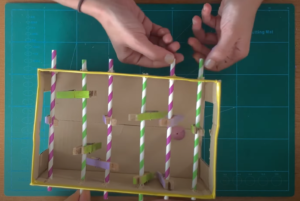Hands On Projects For Homeschoolers
For homeschooling moms seeking hands-on projects to enhance their children’s learning experiences, there are several engaging and educational activities to consider. One effective approach is integrating science experiments into daily lessons. Simple projects like creating a volcano eruption with baking soda and vinegar or growing crystals from salt can vividly illustrate scientific concepts and spark curiosity.
Arts, Crafts & Language
 Additionally, incorporating craft-based activities can reinforce subjects like history and geography; for example, building a diorama of an ancient civilization or crafting a model of the solar system provides a tactile and visual way to explore these topics. Language arts can also benefit from hands-on projects, such as designing and illustrating a homemade storybook or creating a personal dictionary with unique words and definitions. These projects not only make learning more interactive but also help children retain information through creative and practical applications.
Additionally, incorporating craft-based activities can reinforce subjects like history and geography; for example, building a diorama of an ancient civilization or crafting a model of the solar system provides a tactile and visual way to explore these topics. Language arts can also benefit from hands-on projects, such as designing and illustrating a homemade storybook or creating a personal dictionary with unique words and definitions. These projects not only make learning more interactive but also help children retain information through creative and practical applications.
Entry-Level Engineering Projects:
Start with foundational projects that introduce basic engineering concepts. Building simple structures with materials like popsicle sticks or LEGO bricks can teach principles of stability, balance, and design. For instance, constructing a bridge or tower from these materials helps students understand load distribution and structural integrity. Another entry-level project is creating a basic circuit with a battery, light bulb, and wires, which introduces the fundamentals of electricity and circuitry. Simple robotics kits are also excellent for beginners, allowing students to assemble and program basic robots to perform tasks or follow commands, thereby learning about mechanical and software engineering in an accessible way.
Advanced Projects:
 For more advanced learners, consider tackling projects that require a deeper understanding of engineering principles and problem-solving skills. Designing and building a small-scale catapult or trebuchet can explore concepts of physics, mechanics, and precision engineering. Students can further their learning by experimenting with different materials and designs to optimize performance. Another advanced project is developing a miniature solar-powered vehicle. This project integrates concepts from renewable energy and mechanical engineering, challenging students to design a vehicle that operates efficiently on solar power. Additionally, delving into 3D modeling and printing can provide a comprehensive experience with design and manufacturing processes, as students create and produce their own custom designs.
For more advanced learners, consider tackling projects that require a deeper understanding of engineering principles and problem-solving skills. Designing and building a small-scale catapult or trebuchet can explore concepts of physics, mechanics, and precision engineering. Students can further their learning by experimenting with different materials and designs to optimize performance. Another advanced project is developing a miniature solar-powered vehicle. This project integrates concepts from renewable energy and mechanical engineering, challenging students to design a vehicle that operates efficiently on solar power. Additionally, delving into 3D modeling and printing can provide a comprehensive experience with design and manufacturing processes, as students create and produce their own custom designs.
These projects not only build technical skills but also encourage creativity and critical thinking, making them invaluable tools for a well-rounded engineering education at home.
Vacuums & Pumps
Understanding the basics of a vacuum pump can be an exciting and educational experience for homeschooling students. A vacuum pump is a device that removes air and other gases from a sealed container to create a vacuum, or a space with reduced pressure. Here’s a simple overview to introduce the concept:
What Is a Vacuum Pump?
A vacuum pump works by removing air and gases from a sealed environment. This process lowers the pressure inside the container compared to the outside atmosphere. The basic principle is to create a low-pressure area, which can then be used for various scientific and industrial applications.
How Does It Work?
There are several types of vacuum pumps, but the most common ones for educational purposes are the rotary vane pump and the diaphragm pump. The rotary vane pump uses a rotating mechanism to push air out of the pump chamber, while the diaphragm pump uses a flexible diaphragm to create a vacuum. Both types operate on the principle of reducing air pressure inside a chamber. A great way to dive into the inter workings are using a vacuum pump rebuild kit , to see how each component works together.
Hands-On Activity: Simple Vacuum Pump Demonstration
To demonstrate how a vacuum pump works, you can create a basic setup at home. Start with a small, clear plastic jar and a bicycle pump (which can act as a simple vacuum pump). Attach a one-way valve to the jar so air can only flow out but not in. Using the bicycle pump, you can manually remove air from the jar, illustrating how the vacuum pump decreases air pressure.
